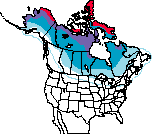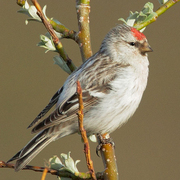Hoary Redpoll
General Description
A close relative of the Common Redpoll and extremely similar in appearance, the Hoary Redpoll nests on High Arctic tundra in the Old and New Worlds. In North America it winters southward across Canada and rarely into the northern contiguous United States, usually in small numbers mixed in with flocks of Common Redpolls. In general Hoary Redpoll appears grayer (less brown) than Common, as if dredged in flour; it is also slightly larger and has a shorter bill. Specific field marks to look for include the Hoary’s unstreaked white rump; undertail coverts either unstreaked or with a single fine streak; and streaking on the sides less extensive and finer than on Common. Adult males are lightly flushed pale pink on the breast, as opposed to the uniform deep-rose breast coloration of Common. However, characteristics of the two species overlap, and not all redpolls can be safely separated in the field.
Although irregularly common in northeastern British Columbia east of the Continental Divide, Hoary Redpoll is a casual visitor elsewhere in the province, as it is in Idaho. During the unprecedented irruption of Common Redpolls in the winter of 2001–2002 at least 15 Hoary Redpolls were reported in Idaho. Six of Washington’s 12 accepted records came during that same winter. Oregon has just two accepted records, both of them from the northeastern part of the state.
Revised November 2007
North American Range Map


Family Members
 BramblingFringilla montifringilla
BramblingFringilla montifringilla Gray-crowned Rosy-FinchLeucosticte tephrocotis
Gray-crowned Rosy-FinchLeucosticte tephrocotis Pine GrosbeakPinicola enucleator
Pine GrosbeakPinicola enucleator Purple FinchCarpodacus purpureus
Purple FinchCarpodacus purpureus Cassin's FinchCarpodacus cassinii
Cassin's FinchCarpodacus cassinii House FinchCarpodacus mexicanus
House FinchCarpodacus mexicanus Red CrossbillLoxia curvirostra
Red CrossbillLoxia curvirostra White-winged CrossbillLoxia leucoptera
White-winged CrossbillLoxia leucoptera Common RedpollCarduelis flammea
Common RedpollCarduelis flammea Hoary RedpollCarduelis hornemanni
Hoary RedpollCarduelis hornemanni Pine SiskinCarduelis pinus
Pine SiskinCarduelis pinus Lesser GoldfinchCarduelis psaltria
Lesser GoldfinchCarduelis psaltria American GoldfinchCarduelis tristis
American GoldfinchCarduelis tristis Evening GrosbeakCoccothraustes vespertinus
Evening GrosbeakCoccothraustes vespertinus

